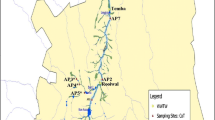Abstract
The horizontal and vertical distribution of the gram-positive, non-motile, spore-forming and rod-shaped bacterium Clostridium perfringens Holland was studied. The aim of the study was to estimate the quantity of C. perfringens at different depths of the sediment and evaluate the effect of human effluent which the lake received between 1940 and 1956. C. perfringens lives in the colon of man. Because it is spore forming and cannot multiply under a temperature of 20 °C and, according to the studies of Seppänen et al. (1979) it can be at least 300 years old, it may be a suitable paleolimnological indicator of pollution by human effluent.
The results showed that the amounts of Clostridium increased at the same level where redox potential decreased in the sediment due to the beginning of effluent disposal at a depth of 40 mm. The maximum number of Clostridium colonies occurred between 0–30 mm depth.
Similar content being viewed by others
References
Bonde, G. J., 1963. Bacterial indicators of water pollution. 2nd ed. Teknisk forlag. Copenhagen. 422 pp.
Granberg, K., 1972. Tuomiojärven tutkimus vv. 1970–1971. Summary: The limnological studies of Lake Tuomiojärvi in 1970–1971. Rep. Hydrobiol. Res Inst. 31: 1–61.
Granberg, K., 1976. Asumajätevesien leviäminen Pohjois-Päijänteelle Clostridium perfringens-bakteerin perusteella. Summary: The distribution of human effluents into Northern Päijänne according to the amounts of Clostridium perfringens in the sediments. Rep. Hydrobiol. Res. Inst. 77: 1–16.
Granberg, K. & Nyrönen, J., 1978. Tuomiojärven limnologiset tutkimukset vv. 1975–1976. Summary: The limnological studies of Lake Tuomiojärvi in 1975–1976. Rep. Hydrobiol. Res. Inst. 83: 1–41.
Hallberg, R. O., 1974. Paleoredox conditions in the Eastern Gotland Basin during the recent centuries. Merentutkimuslait. Julk. no 238: 3–16.
Harjula, H., 1972. Hiidenveden ja Tuusulanjärven rehevöitymisen kehitys pohjasedimenttien valossa. Institute of Limnology, University of Helsinki.
Niemelä, S., 1978. Vesianalyysin tulostaminen ja tulosten merkitsevyyden arviointi. B. Mikrobiologiset menetelmät. Ympäristö ja Terveys 7: 479–482.
Palomäki, A., 1978. Paleolimnologinen tutkimus luonnontilaisesta, rehevöityneestä ja puunjalostusteollisuuden muuttamasta järvestä. Department of Hydrobiology, University of Jyväskylä.
Parsons, T. R. & Strickland, J. D. H., 1963. Discussion of spectrophotometric determination of marine plant pigments with revised equations for ascertaining chlorophylls and carotenoids. J. Mar. Res. 21: 155–163.
Seppänen, H., Ojanen, T. & Zaiss, U., 1979. Die vertikale Verteilung des Fäkalindikators Clostridium perfringens in den Sedimenten des Sees Hiidenvesi. Aqua Fennica.
Vuorinen, J., 1978. The influence of prior land use on the sediments of a small lake. Pol. Arch. Hydrobiol. 25: 443–451.
Author information
Authors and Affiliations
Rights and permissions
About this article
Cite this article
Granberg, K. Clostridium perfringens (Holland) as an indicator of human effluent in the sediment of Lake Tuomiojärvi, central Finland. Hydrobiologia 103, 181–184 (1983). https://doi.org/10.1007/BF00028449
Issue Date:
DOI: https://doi.org/10.1007/BF00028449




